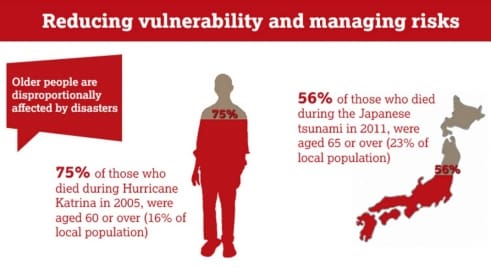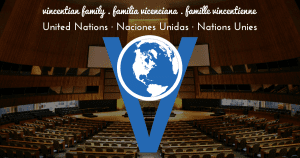UN Commission to Consider Impact of Conflict/Disasters Upon Three Groups
UN Commission to Consider Impact of Conflict/Disasters Upon Older Persons, Persons with Disabilities, and Youth

Refugees – La Sagrada Familia by Karen Lattimore
With the birth of Jesus less than a week away, we are mindful that the story of the Nativity involved not only the Incarnation but also a threatened leader (Herod) and the death of innocent children. The UN is quite aware that children remain at significant risk during conflicts in our day.
In keeping with this concern, the 2019 Commission on Social Development (known as “CSOCD”) will feature an emerging theme which relates to how youth, older persons, and persons with disabilities are affected by conflict and both man-made and natural disasters. Perhaps they are the “holy innocents” of our day. The Commission takes place February 11-21 in New York.
One source of statistics which examines the impact on of both conflict and disaster is the Global Report on Internal Displacement (GRID) report by the Internal Displacement Monitoring Centre (IDMC). It notes that 18,780,000 persons were displaced by disasters in 2017, while 11,774,000 were displaced by conflicts, for a total of 30.6 million people.
Let’s take a glimpse at some areas of concern related to children and youth, older persons, and persons with disabilities, related to conflict or disasters.
Effects Of Conflict On Children
About 357 million children—1 in 6 children–globally are affected by conflict, according to a Save the Children International report from February, 2018. The report is entitled, The War on Children: Time to End Violations Against Children in Armed Conflict.
The Report reflects that almost half of the 357 million children live in areas of high intensityconflict. Think of Syria, the Rohingyan crisis, Yemen, and the Democratic Republic of the Congo, to name just a few such areas.
To view the Save the Children International 2018 report, “The War on Children: Time to End Violations Against Children in Armed Conflict,” click here.
In the report, Save the Children CEO, Helle Thorning-Schmidt, points out some concerning information. “The number of children verified by the UN as killed or maimed has risen drastically in the last 10 years,” she says. “Reports of life-saving aid such as food, water and medicine being blocked are up more than 1,500 percent since 2010. Attacks on what should, by any law or civilized standard, be safe places for children – such as schools and hospitals – are also becoming a new normal in conflicts, with reported incidents having roughly doubled in the last decade.”
The UN speaks of six grave violations, and children in conflict situations are at risk of experiencing them. The six are: killing and maiming, recruitment and use of children, sexual violence, abduction, attacks on schools and hospitals, and denial of humanitarian assistance. According to the World Health Organization, for every children killed in warfare, three are injured and acquire a permanent disability. In addition to these risks, children in conflict situations can also encounter a lack of medical attention, counseling, education, food, potable water, and are at risk of illness.

Source: Save the Children
Persons With Disabilities Affected By Conflict
Persons with disabilities also face significant risks during conflict. Imagine that you require the assistance of a wheelchair, that you cannot hear, or do not have sight, and are trying to flee an armed conflict. Challenges abound. Imagine, for example, that you are left behind and subject to physical or sexual assault, that you are mired in a muddy escape path in a wheelchair, or that you are competing with more mobile persons for basic necessities, such as food and water.
An April, 2018 Issue Brief Syria by Humanity & Inclusion reported that estimates of 2.9 million people inside Syria are living with a permanent disability and that there are 30,000 new conflict-related trauma cases per month. (Source)
Disabled persons were targeted during the Holocaust. An estimated 250,000 persons with disabilities were killed at that time. (Source)
Human Rights Watch discovered many Rohingya refugees with disabilities at a Bangladesh refugee camp, with many of the disabilities caused by attacks by Myanmar’s military. (Source)
The National Assistance Fund for Needy Survivors of Genocide and Massacres in Rwanda (FARG) estimated that 300,000 survivors of the Rwandan genocide were disabled, and that approximately 26,000 were missing one or more limbs. Mutabazi (1998) notes that there was a large-scale slaughter of deaf people, and that Hutu soldiers and death squads killed almost all of the 750 mentally handicapped patients in Rwanda’s psychiatric hospital. (Source, page 18)

Source: UN
Older Persons And Disasters
Concerns for elderly persons were prominent in the recent Camp Fire in California. A Time Magazine article by Tara Law, from November 12, 2018, quoted a woman who escaped. She indicated that many of her neighbors in Paradise, California, were elderly, persons with disabilities, or persons who did not have cars.
Hurricanes and typhoons also pose a serious problem for persons who are elderly. According to HelpAge, almost two fifths of people killed by Typhoon Haiyan (the Philippines) were over the age of 60 –even though that age represented 8% of the general population in the worst affected areas. (Source)
HelpAge also reported that in Hurricane Katrina, 49% of those killed were over 75, while in the 2011 earthquake in Japan, 64% of those killed were over 60.

Source: HelpAge International
Our Call
There are many “holy innocents” in need of assistance this Christmas. How might we, as a Vincentian Family, support them?

Tags: United Nations







0 Comments